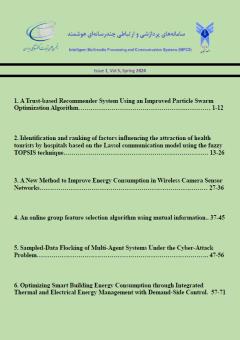ارائه روشی جدید به منظور بهبود دادن مصرف انرژی در شبکههای حسگر دوربین بیسیم
الموضوعات : Multimedia Processing, Communications Systems, Intelligent Systems
1 - دانشجو کارشناسی ارشد، گروه برق، واحد زنجان، دانشگاه آزاد اسلامی، زنجان، ایران
2 - استادیار، گروه برق، واحد زنجان، دانشگاه آزاد اسلامی، زنجان، ایران
الکلمات المفتاحية: الگوریتم ژنتیک, انرژی مصرف شده, الگوریتم بهینهسازی شاهین هریس, خوشهبندی, شبکههای حسگر دوربین بیسیم,
ملخص المقالة :
در چند سال اخیر، شبکههای حسگر بیسیم از زمینه های تحقیقاتی بسیار فعال بودهاند. با این حال، بیشتر حسگرهای مورد استفاده در توسعه این شبکهها، حسگرهای معمولی و غیرتصویربرداری مانند صوتی، لرزهای، دما، رطوبت و غیره بودهاند. در توسعه شبکههای حسگر دوربین بیسیم چالشهای منحصر به فردی همانند نیاز به پهنای باند بالا، نیاز به تأخیر اندک برای پردازش، انرژی مصرفی بالا و کنترل در زمان واقعی وجود دارد. در این مقاله یک مدل پیشنهادی جدید برمبنای الگوریتم بهینهسازی شاهین هریس به منظور بهبود مصرف انرژی در شبکههای حسگر دوربین بیسیم پیشنهادشده است. الگوریتم بهینهسازی شاهین هریس یکی از الگوریتمهای فراابتکاری است که در سال 2019 ابداع شده است. از الگوریتم بهینهسازی شاهین هریس برای تشکیل خوشهبندی بهینه استفاده می شود. هر بردار تولیدشده در الگوریتم بهینهسازی شاهین هریس برمبنای تابع برازندگی محاسبه میشود و بهینهترین بردارها جهت خوشهبندی انتخاب میشوند. در مدل پیشنهادی به فاکتورهایی همانند فاصله درون خوشهای و فاصله برون خوشهای و انرژی مصرفی توجه شده است. ارزیابیها در محیط با تعداد گرههای مختلف نشان میدهد که مدل پیشنهادی در مقایسه با PADT و الگوریتم ژنتیک (GA) دارای کارایی بهتری بوده است.
[1] X. Liu, “A Survey on Wireless Camera Sensor Networks,” in Frontier and Future Development of Information Technology in Medicine and Education, Dordrecht: Springer Netherlands, 2014.
[2] M. Rouan Serik and M. Kaddour, “Optimizing Deployment Cost in Camera-Based Wireless Sensor Networks,” in Computer Science and Its Applications, Cham: Springer International Publishing, 2015.
[3] A. Mosaif and S. Rakrak, “A Survey of Cross-Layer Design for Wireless Visual Sensor Networks,” in Innovations in Bio-Inspired Computing and Applications, Cham: Springer International Publishing, 2018.
[4] W. Li and W. Zhang, “Multiple target localization in wireless visual sensor networks,” Frontiers of Computer Science, Vol. 7, No. 4, pp. 496-504, 2013.
[5] R. Priyadarshi, B. Gupta, and A. Anurag, “Deployment techniques in wireless sensor networks: a survey, classification, challenges, and future research issues,” The Journal of Supercomputing, Vol. 76, No. 9, pp. 7333-7373, 2020.
[6] D.G. Costa and L.A. Guedes, “Exploiting the sensing relevancies of source nodes for optimizations in visual sensor networks,” Multimedia Tools and Applications, Vol. 64, No. 3, pp. 549-579, 2013.
[7] A. Zam, M.R. Khayyambashi, and A. Bohlooli, “Energy-aware strategy for collaborative target-detection in wireless multimedia sensor network,” Multimedia Tools and Applications, Vol. 78, No. 13, pp. 18921-18941, 2019.
[8] A. Tavli, K. Bicakci, R. Zilan, and J.M. Barcelo-Ordinas, “A survey of visual sensor network platforms,” Multimedia Tools and Applications, Vol. 60, No. 3, pp. 689-726, 2012.
[9] H. Medeiros, J. Park, and A. Kak, “A Light-Weight Event-Driven Protocol for Sensor Clustering in Wireless Camera Networks,” in 2007 First ACM/IEEE International Conference on Distributed Smart Cameras, 2007.
[10] A.A. Heidari, S. Mirjalili, H. Faris, I. Aljarah, M. Mafarja, and H. Chen, “Harris hawks optimization: Algorithm and applications,” Future Generation Computer Systems, Vol. 97, No., pp. 849-872, 2019.
[11] F.S. Gharehchopogh and B. Abdollahzadeh, “An efficient harris hawk optimization algorithm for solving the travelling salesman problem,” Cluster Computing, Vol. No., pp. 2021.
[12] A. Zam, M.R. Khayyambashi, and A. Bohlooli, “Energy-efficient face detection and recognition scheme for wireless visual sensor networks,” Applied Soft Computing, Vol. 89, No., pp. 106014, 2020.
[13] E.O. Rangel, D.G. Costa, and A. Loula, “On redundant coverage maximization in wireless visual sensor networks: Evolutionary algorithms for multi-objective optimization,” Applied Soft Computing, Vol. 82, No., pp. 105578, 2019.
[14] Behrooz Shahrokhzadeh, Mehdi Dehghan, and M.R. Shahrokhzadeh, “Improving Target Coverage in Visual Sensor Networks by Adjusting the Cameras’ Field-of-View and Scheduling the Cover sets Using Simulated Annealing,” NASHRIYYAH-I MUHANDESI-I BARQ VA MUHANDESI-I KAMPYUTAR-I IRAN (PERSIAN), Vol. 14, No. 4, pp. 271-285, 2016.
[15] M. Parandeh and S.H. Aghdasi, “Position-based Energy-Efficient Data Forwarding Protocol for Visual Sensor Networks,” TABRIZ JOURNAL OF ELECTRICAL ENGINEERING, Vol. 47, No. 1, pp. 29-38, 2017.
[16] M.M. Kheirkhah and M. Khansari, “Clustering wireless camera sensor networks based on overlapped region detection,” in 7'th International Symposium on Telecommunications (IST'2014), 2014.
[17] L. Liu, M. Anlong, H. Ma, and X. Zhang, “A binary-classification-tree based framework for distributed target classification in multimedia sensor networks,” in 2012 Proceedings IEEE INFOCOM, Orlando, FL, USA, 2012.
[18] R.P. Meenaakshi Sundhari and K. Jaikumar, “IoT assisted Hierarchical Computation Strategic Making (HCSM) and Dynamic Stochastic Optimization Technique (DSOT) for energy optimization in wireless sensor networks for smart city monitoring,” Computer Communications, Vol. 150, No., pp. 226-234, 2020.
[19] [19] Z. Zuo, Q. Lu, and W. Luo, “A two-hop clustered image transmission scheme for maximizing network lifetime in wireless multimedia sensor networks,” Computer Communications, Vol. 35, No. 1, pp. 100-108, 2012.
[20] A. De San Bernabe, J.R. Martinez-de Dios, and A. Ollero, “Efficient integration of RSSI for tracking using Wireless Camera Networks,” Information Fusion, Vol. 36, No., pp. 296-312, 2017.
[21] F.S. Gharehchopogh and H. Gholizadeh, “A comprehensive survey: Whale Optimization Algorithm and its applications,” Swarm and Evolutionary Computation, Vol. 48, No., pp. 1-24, 2019.
[22] M. Ehsan, N. Amir, and A. Mojtaba, “An Enhanced Dynamic Source Routing Algorithm for the Mobile Ad-Hoc Network using Reinforcement learning under the COVID-19 Conditions,” Journal of Computer Science, Vol. 16, No. 10, pp. 2020.
[23] S. Rhee, H.-Y. Choi, H.-J. Lee, and M.-S. Park, “Power-Aware Data Transmission for Real-Time Communication in Multimedia Sensor Networks,” International Journal of Distributed Sensor Networks, Vol. 10, No. 6, pp. 405171, 2014.


